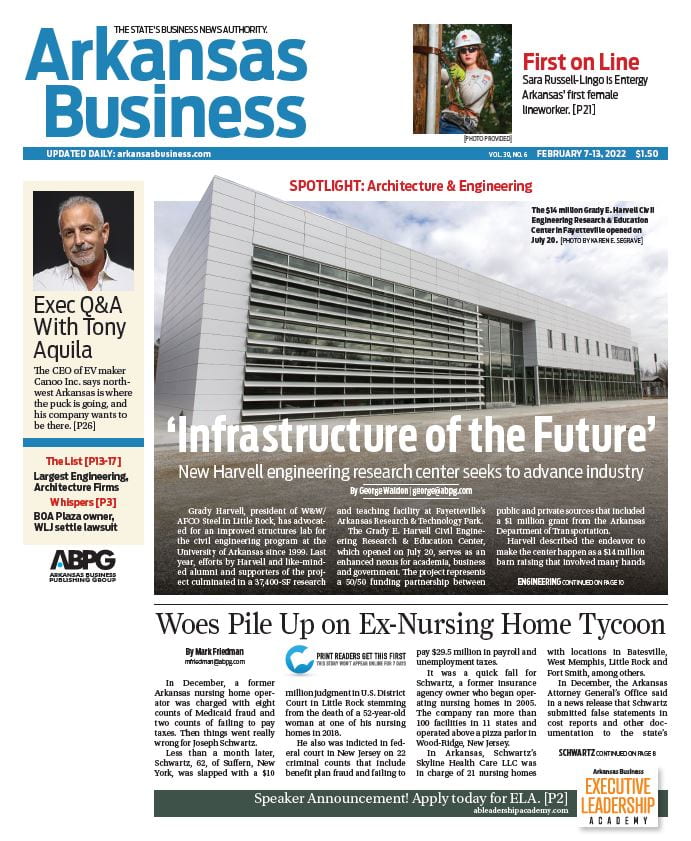New Harvell Engineering Research Center Seeks to Advance Industry
By George Waldon | Monday, Feb. 7, 2022

Grady Harvell, president of W&W/AFCO Steel in Little Rock, has advocated for an improved structures lab for the civil engineering program at the University of Arkansas since 1999. Last year, efforts by Harvell and like-minded alumni and supporters of the project culminated in a 37,400-SF research and teaching facility at Fayetteville’s Arkansas Research & Technology Park.
The Grady E. Harvell Civil Engineering Research & Education Center, which opened on July 20, serves as an enhanced nexus for academia, business and government. The project represents a 50/50 funding partnership between public and private sources that included a $1 million grant from the Arkansas Department of Transportation.
Harvell described the endeavor to make the center happen as a $14 million barn raising that involved many hands signing checks.
“I gave a pretty good chunk of it, but there were a lot of people who kicked in money,” Harvell said. “I’d hate to start naming names because I’m afraid I’d leave somebody out.”
Known as CEREC, the facility is a one-of-a-kind in Arkansas that provides an in-state, large-scale structural components testing option.
The centerpiece of the building is a high-bay area with a 4-foot-thick strong-floor to anchor large-scale structural systems and components for extreme load testing. Overhead, a 25-ton rail crane provides the lifting muscle to move heavy material.
When hydraulic pressure is brought to bear from different angles, the tie-downs of the strong-floor system can withstand 220,000 to 240,000 pounds of load depending on the direction of force.
Surrounding the high-bay area are a concrete testing lab, a metallurgy lab to prepare samples for microscopic fracture investigation after testing, a materials lab for stress-testing smaller components and a machine shop.
“Without all this, you don’t get the infrastructure of the future,” said Gary Prinz, director of the center and associate professor of civil engineering.
The UA expects CEREC to serve as a laboratory for several hundred students annually, with space for 15 faculty members to conduct research. The upgrade is considered a boon for attracting more students.
‘A Better Competitive Situation’
Harvell, a 1972 civil engineering graduate of the UA, said the center’s structural testing and material science laboratory elevates the civil engineering program and creates a platform to achieve industry advancements.
“I’m just trying to keep my part of the discipline advancing along with the rest of them,” he said of the degree programs in the College of Engineering. “This puts us in a better competitive situation in the civil engineering world.”
Projected to cost $15 million, a future Phase II would expand lab capabilities for geotechnical, transportation and other civil engineering disciplines.
Liza Moriconi, a civil engineering honors student on track to graduate in May, talked about her work at the center with a touring visitor. She’s dealing with strain gauges, measuring the effect of simulated earthquake stress as part of a seismic cyclic testing on beam columns.
“I never thought I’d be participating in something like this,” Moriconi said of her role in the project.
The big-picture research is examining possibilities for expanded design flexibility for steel connections. The ideal is to prevent fracturing, but if a crack occurs, the design should force it away from the weld to minimize the damage.
Jim McClelland, a 1967 UA civil engineering graduate, noted the welcome change in gender demographics while visiting the center.
“When we were in school, there were zero young ladies,” said McClelland, chairman emeritus of Little Rock’s McClelland Consulting Engineers.
The female enrollment of undergraduate civil engineering students has grown from 10% 20 years ago to about 30% at the UA. Of the current graduate students in the program, seven (40%) are women, according to Micah Hale, head of the Civil Engineering Department.
Shear Stud Quandary
The expanded capabilities of the center are positioned to build on a notable research effort nearing fruition.
The project began with a nagging question that had bothered Harvell for quite a while and came to the forefront
in 2014. He surveyed rows of steel at W&W/AFCO Steel’s Little Rock fabrication yard on a tour with members of the UA civil engineering faculty.
All those beams spiked with scores of shear studs bound for highway bridges sparked a conversation along the lines of:
“Why are we using so many gosh darn shear studs?” Harvell asked.
“I don’t know,” answered the UA’s Prinz. “Why are we using so many gosh darn shear studs?”
The simple answer is that’s what the American Association of State Highway & Transportation Officials code requires. Contract specifications for the 30 Crossing bridges under construction in Little Rock and North Little Rock call for 178,561 shear studs.
But are so many really necessary to provide connectivity between steel and concrete for safe, durable highway bridges? It was a question without a definitive, quantifiable answer that started a research project in Fayetteville that is expected to produce change in advance of 2023 publishing in the AASHTO code.
“It’s still ongoing,” Prinz said of the process. “Presentations are still happening, and there’s still more work behind the scenes to get it implemented. What we’ve done is provide more information to make better decisions.”
When the industrial standards change, fewer shear studs will be welded on steel beams, resulting in a sizable savings in time and dollars. Harvell estimates the reduced count could trim 0.5%-1% from the cost of a highway bridge.
“If you can save 0.75% on delivered steel on a project, that gets to be big money,” Harvell said. “But this is a matter of life and safety. It’s not a casual thing to change. You have to have a good set of data and be able to defend the findings before multiple reviews.”
W&W/AFCO provided a $100,000 grant in 2015 to get the ball rolling to test whether the number of shear studs specified by the AASHTO code was overkill.
“We continue to push the needle forward to make things more economic and easier to do,” Prinz said. “We develop innovation to our nation’s infrastructure.”
